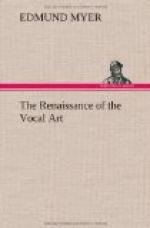The disciples of the local-effort school lose sight of the fact that when a muscle is set and rigid, either in attempting to hold the breath or to force the tone, it is virtually out of action; that instead of actually helping the voice it is really preventing a free, natural production, and that other parts are then compelled to do its work; this accounts for many ruined voices. “To make a part rigid is equal to the extirpation of such part. While it is in a state of rigidity it ceases to take part in any action whatsoever: it is inert and the same as if it had ceased to exist.”
The local-effort school is accountable for many errors of the day. The incubus of this school is fastened upon the vocal profession with octopus-like tentacles which reach out in every direction, and which strive to strangle the truth in every possible way; but, while “life is short, art is long;” the truth must prevail.
* * * * *
As an outgrowth of the local-effort school, and as an attempt to counteract its evil tendencies, there is to-day in existence another school or system known as the limp or relaxed school, or the system of complete relaxation. The object of this relaxation is to overcome muscular tension and rigidity. This is the other extreme. The followers of this school forget that there can be no tonicity without tension. Flexible firmness without rigidity, the result of flexible, vitalized position and action, is the only true condition. The tone of the school of relaxation is nearly always depressed and breathy; it always lacks vitality.
ARTICLE FOUR.
The renaissance of the vocal art.
We are in the habit of measuring time by days, weeks, months, years, decades and centuries. The world at large measures time by epochs and eras. While this is true in the physical world, it is equally true of the arts and sciences, and it is especially true of the art of song. Thus we have had the period known as “The Old Italian School of Singing.” This was followed by the modern school, or “The Local-Effort School” of the nineteenth century, the period which may be called The Dark Ages of the Vocal Art.
There is a constant evolution in all things progressive, and this evolution is felt very perceptibly to-day in the vocal world. Great principles, great truths, are of slow growth, slow development. Times change, however, and we change with them. While the changes may be slow and almost imperceptible to the observer, they are sure, and finally become evident by the accumulation of event after event.
The prevailing systems of the nineteenth century tried to develop voice by direct local muscular effort. These systems have proved themselves failures. The vocal world is looking for and demanding something better. We may say that we are now on the eve of great events in the vocal art. When the morn comes, and the light breaks, we may confidently expect that awakening or reawakening which may properly be called The Renaissance of the Vocal Art.




